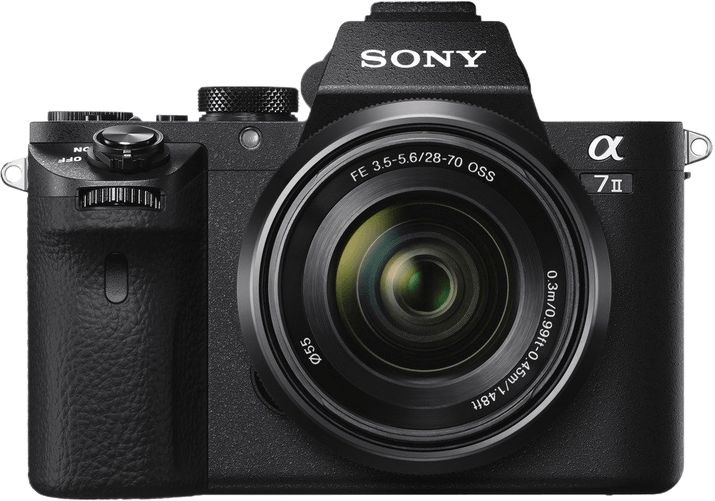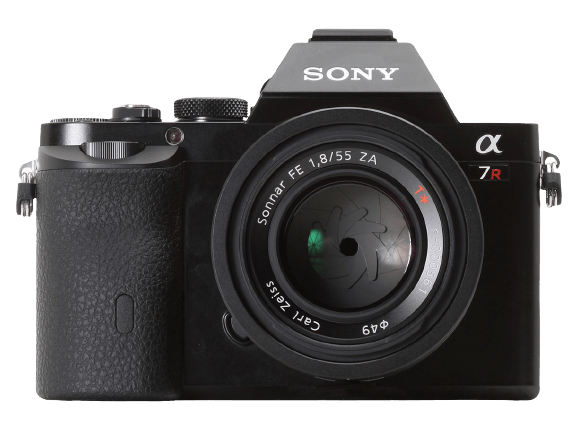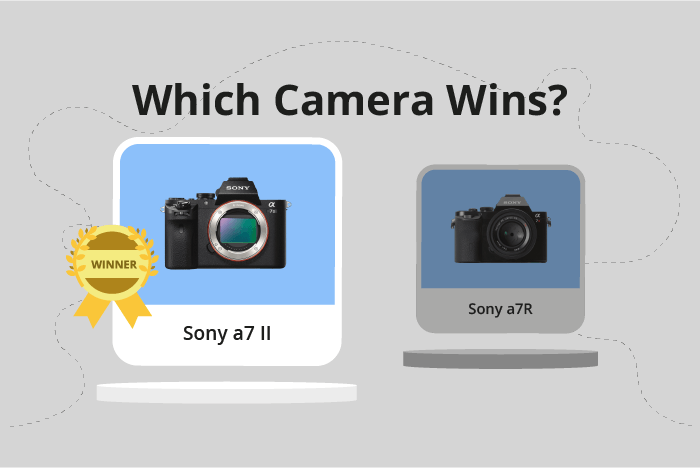Sony a7 II vs a7R Comparison
Sony a7 II

Sony a7R

The Sony a7 II emerges as the winner with a score of 69/100, while the Sony a7R trails with a score of 65/100. Both cameras are mirrorless and share similar dimensions, with the a7 II measuring 127 x 96 x 60mm and the a7R at 127 x 94 x 48mm.
The a7 II is superior in terms of performance and features, justifying its higher score. It was released in 2014 with a launch price of $1600, offering more value for money compared to the a7R’s 2013 release and $2300 price tag. However, the a7 II is heavier, weighing 599g compared to the a7R’s 465g.
Despite its lower score, the Sony a7R stands out for its lighter weight, making it easier to carry around for extended periods. Ultimately, the Sony a7 II offers better value and performance, while the a7R is a more lightweight option for those prioritizing portability.
Sony a7 II vs a7R Overview and Optics
The Sony a7 II emerges as the winner in optics, scoring 78/100, while the Sony a7R scores 74/100. Both cameras share some common specifications, such as a CMOS sensor, Bionz X processor, and full-frame sensor size. They also have different lens mounts, with the Sony a7 II using Sony E and the Sony a7R using Sony FE.
The Sony a7 II outperforms the a7R in several key areas. First, it has a higher shooting speed of 5 compared to the a7R’s 4, allowing for faster continuous shooting. Additionally, the a7 II features image stabilization, which the a7R lacks. This makes the a7 II more versatile for shooting in various conditions and minimizing camera shake, resulting in sharper images.
Despite having a lower score, the Sony a7R has its own strengths. It boasts a higher megapixel count of 36 compared to the a7 II’s 24.2, which translates to more detailed and higher resolution images. Furthermore, the a7R has a higher DXOMARK sensor score of 95, as opposed to the a7 II’s 90. This indicates superior image quality and dynamic range performance.
Taking these factors into account, the Sony a7 II’s faster shooting speed and image stabilization make it a more versatile camera for different shooting scenarios. However, the Sony a7R excels in image quality and resolution, making it more suitable for photographers who prioritize detail and dynamic range. Ultimately, the choice between these two cameras depends on the specific needs and preferences of the photographer.
Sony a7 II vs a7R Video Performance
The Sony a7 II and the Sony a7R both have identical video scores of 56/100. This means that neither camera outperforms the other in terms of video capabilities. Both cameras share common specifications, such as Full HD (1920 x 1080) maximum video resolution and a maximum video frame rate of 60fps. Neither camera has built-in time-lapse functionality.
Despite having the same video score, there are areas where one camera may be better than the other. In the case of the Sony a7 II, its video capabilities are on par with the Sony a7R. This means that the Sony a7 II is not better than the Sony a7R in terms of video capabilities, as they both have the same specifications.
On the other hand, the Sony a7R also does not have any distinct advantages over the Sony a7 II when it comes to video capabilities. Both cameras offer the same Full HD resolution, maximum video dimensions, and maximum video frame rate. The lack of built-in time-lapse functionality is also consistent between the two cameras.
In comparing the video capabilities of the Sony a7 II and the Sony a7R, it is clear that both cameras are equal in this aspect. Neither camera has a significant advantage over the other, as they both share the same video specifications and score. Thus, users can expect similar video performance and quality from both the Sony a7 II and the Sony a7R.
Sony a7 II vs a7R Features and Benefits
The Sony a7 II and the Sony a7R both have a feature score of 57/100. These cameras share several specifications, making them quite similar in terms of features. Both cameras have a 3-inch screen with a resolution of 1,230,000 dots. Neither camera has a touchscreen, but they both have a flip screen. Additionally, both cameras lack GPS but come with WIFI capabilities. Neither camera has Bluetooth.
The Sony a7 II offers the same features as the Sony a7R, making it difficult to determine which camera is better based on features alone. Both cameras have a flip screen, which is useful for shooting from different angles and perspectives. The lack of a touchscreen may not be an issue for some users, as the flip screen and control dials can provide adequate control over the camera settings.
The Sony a7R, despite having the same feature score as the Sony a7 II, does not have any notable advantages in terms of features. It shares the same screen size, resolution, flip screen, WIFI, and lack of GPS and Bluetooth as the Sony a7 II.
Based on the features alone, there is no clear winner between the Sony a7 II and the Sony a7R. Both cameras offer a similar set of features, with neither camera having a significant advantage over the other. Users should consider other factors, such as performance, image quality, and price, when deciding between these two cameras.
Sony a7 II vs a7R Storage and Battery
The Sony a7 II and Sony a7R are close competitors in storage and battery. Both cameras have one memory card slot and accept SD/SDHC/SDXC and Memory Stick Duo/Pro Duo/Pro-HG Duo cards. They also share the same battery type, NP-FW50.
The Sony a7 II has a slight advantage in battery life, providing 350 shots compared to the Sony a7R’s 340 shots. This difference may not be significant for casual users but could be crucial for professional photographers who need longer shooting sessions.
On the other hand, the Sony a7R does not have any distinct advantages in storage and battery compared to the Sony a7 II. Both cameras perform similarly in this aspect, making it difficult to choose a clear winner based on storage and battery alone.
Considering these points, the Sony a7 II and Sony a7R are evenly matched in terms of storage and battery. Users should examine other features and specifications to determine which camera best suits their needs.
Alternatives to the Sony a7 II and a7R
Are you still undecided about which camera is right for you? Have a look at these popular comparisons that feature the Sony a7 II or the Sony a7R:

